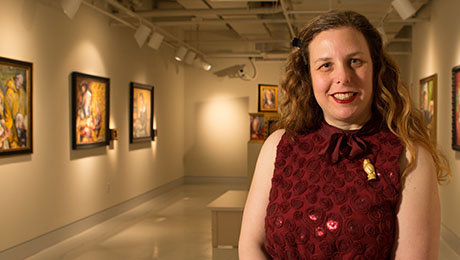Holly Trostle Brigham, M.F.A. ’94, is present in each painting featured in her newest exhibit, “Dis/Guise.” The George Washington University alumna uses her own physical features to create powerful images of real women who existed in different eras—the result is self-portraiture that explores identity, sexuality and how the female body has been depicted throughout history.
“Dis/Guise” opened at the Luther W. Brady Gallery last week. The show, which originated at Ursinus College’s Berman Museum in Pennsylvania, includes work from Ms. Brigham’s series, “Seven Sisters” and “Seven Sisters II,” and an installation piece called “Hildegard’s Box.”
Ms. Brigham came to GW to pursue her dream of becoming a visual artist after studying art history as an undergraduate at Smith College and as a master’s student at the University of Pittsburgh. She established her unique style when she was pursuing her M.F.A., winning GW’s David Lloyd Kreeger and Cecil Hunt prizes for art in 1992. George Washington Today spoke to her about why she uses self-portraits and historical figures, where she gets inspiration and how her time at GW influenced her latest exhibit.
Q: In “Dis/Guise,” you use yourself as a model to create images of historical women. Have you always worked this way?
A: It started when I was at GW. I’d seen a lot of objectified images of women in art history, and I wanted to create self-possessed nudes. I used myself as a model simply because it was inexpensive and accessible—I could just put a mirror up. Later, I wanted to give my figures an identity.
Audrey Flack, a major female figure in the American photorealist movement, gave a lecture at GW during my time there. She had stopped painting and was helping towns become tourist attractions by creating these gorgeous public sculptures of goddesses. I was really moved, and it made me think about females in mythological stories. I wanted to create images where goddesses were strong and represented positive role models for women.
Once I started doing mythological figures, I thought the next challenge would be historical figures. Something that was ingrained in me at GW was that you make better images if you’re working from life. If you use a photograph, it’s already once removed from the actual person. If I wanted to work from life and do historical figures, I could use myself.
Q: How much of yourself do you put into an image? Do you use any props or costumes?
A: I become anonymous—what’s important to me is the subject. I do as much research as I can and, in a way, I’m more like an actor. There’s also a tradition in historic portraiture where artists would pose society people in the guise of gods, so there’s a lot I’m drawing on in my work.
Sometimes what happens—and I’m not very aware of it—is that I’m altering myself a little bit. When I was painting “Artemesia: Blood for Blood,” I realized she was a heavier person than I was, so I painted myself heavier.
When I painted “Sorella Plautilla Nelli's Lamentation,” I didn’t have a nun’s habit, so I actually used my black printmaking apron from GW and put it over my head.
Q: Where do you get inspiration for the historical women in your work?
A: “Seven Sisters II” is a series of myself disguised as nuns who were creative individuals. I like to deal with subject matter that people maybe don’t know too much about, so I’m hopefully informing them about these amazing women who came before us. I place relics in individual frames besides the paintings to give authenticity to these subjects. My painting of Saint Catherine has my braided hair in a tiny frame, so you’re meant to believe it’s her hair.
The whole idea of the “seven sisters” is a play on the word “sisters,” and it comes from the fact that I went to Smith College, one of the schools of the Seven Sisters. I also thought about the Greek myth of the Pleiades—they were Atlas’s seven daughters, who he saved from being abducted by putting them in the sky as constellations. “Sister” is also a feminist term. I was intrigued by the idea of convents—a group of women getting along, and I knew from art history that many nuns were creating art and murals.
Q: Can you tell us about some of the pieces in the show?
A: When a student graduates with an M.F.A., GW occasionly puts a painting from his or her thesis show into the GW Permanent Collection. GW has “GAEA,” a creator goddess that shows the progression of my style—back then, it was very loose. It’s almost a stained canvas, because I was doing watercolor and oil painting at the same time.
The only installation piece in this show is “Hildegard’s Box.” It's the first piece I made when I began thinking about the Seven Sisters II series. Hildegard of Bingen was a medieval nun and mystic. Inside the box, there are two relics: a heart and tongue made of wax.
Q: How did your time at GW ultimately influence your work?
A: The show that follows mine at the Brady Art Gallery is a tribute to Arthur Hall Smith. I felt a real connection to him—he was my favorite professor at GW. He died in Paris last year. My work could not be the way it is without him. If you look closely at my paintings, you will see a lot of parallel line work. That all comes out of an amazing class I had with Arthur where he taught sumi-e Japanese ink wash painting. In my acknowledgements in the “Dis/Guise” catalogue, I've dedicated the exhibit to him.


